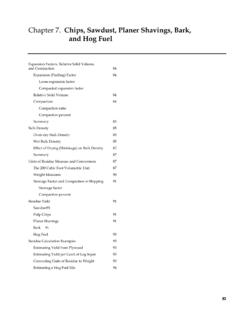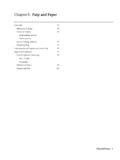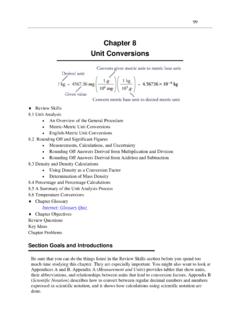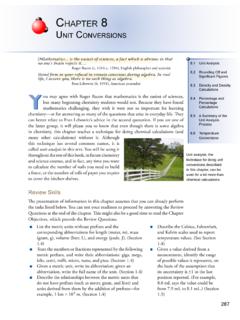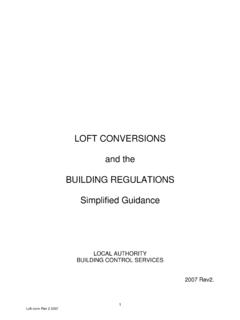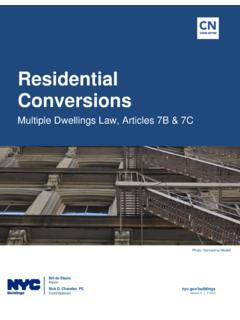Transcription of Chapter 2. Measurement of Logs
1 Measurement of logs 1 Criteria for a Good Log Rule 14 Gross Versus Net Scale 14 Cubic Volume Log Scaling 14 Cubic Volume Formulas 15 Geometric solids Hoppus Interagency Cubic Foot Log Rule 17 Japanese Log Rules 17 Japanese Agricultural Standard (JAS) scale Revised JAS Hiragoku (Hirakoku or Heiseki) scale South Sea Log (SSL) scale or Brererton Comparing the Japanese log rules Traditional Japanese measure: Koku and some conversions Customary conversions for North American softwood logs Korean Log Rules 20 Log Rules for Indonesia, Malaysia, and the Philippines 20 British Columbia Log Rules 21 Chilean Log Rules 21 Russian Log Rules 21 New Zealand Log Rules 21 Measurements Export logs 1.
2 Japanese Haakondahl 2. Japanese Agricultural System and Korean Industrial Standard 3. William Klemme Board Foot Log Scaling 23 Board Foot and Overrun 23 Board foot measure Difference between board foot measure for lumber and log rules Differences between board foot log rule assumptions and sawmill practice Overrun and underrun Formula Board Foot Log Rules 24 International 1/8 and 1/4 inch rules Doyle rule Brererton rule British Columbia rule Haakondahl rule Diagram Board Foot Log Rules 25 Scribner 1. West-side (long log, coast, Bureau) Scribner 2.
3 East-side (short log, 20 foot maxi- mum, inland, Forest Service) Scribner 3. Comparing West-side and East-side Scribner 4. Formulas to approximate Scribner Other diagram board foot log rules Log Rule Conversion Factors 29 Conversions for Formula Log Rules: Algebraic Approach 30 Conversion Using Log Rule Tables 31 Sample Scaling for a Conversion Factor 31 Institutionalized Log Conversion Factors 32 Conversions between cubic systems Conversions between Brererton and Scribner Conversions between board feet and cubic feet or cubic meters Conversions between board foot systems Log Weights 34 Cubic foot weight scaling Board foot weight scaling Log weight calculation Chapter 2.
4 Measurement of logs 2 Chapter 2 Chapter of logs logs are tree sections that are to be converted to products such as lumber, veneer, and plywood. Many log Measurement systems have been devel-oped and can be very confusing. In this Chapter ,a number of important domestic and foreign log Measurement systems, often called log scales orlog rules, are described. Also presented are methods for estimating conversion factors, and some conversion factors commonly used by statistical reporting for a Good Log Rule Log scaling is the process of estimating the weight or volume of a log while allowing for features that reduce product recovery. Scaling in terms of volume has been the predominant method, but weight scaling is common in some industries and for small logs .
5 Many log rules for estimating volume have unique characteristics. Many were devised when lumber was the principal product. Rather than measuring the total volume of the log, they apply lumber manufacturing assumptions to estimate the quantity of lumber a given log will yield. Since lumber is measured in board feet, these are called board foot rules. While these rules may have been adequate in the past, their emphasis on a single product and their antiquated assumptions regarding lumber processing make them poor choices today. In today's complex, multiproduct environment, a good log rule should (1) provide a good estimate of the total wood fiber content, (2) provide a good basis for estimating the yields of alternative products, (3) have the property that when a log is cut into shorter segments, the segment volumes sum to the volume of the original log, and (4) involve simple, easy-to-take measurements (Snellgrove and Fahey 1982).
6 Gross Versus Net Scale Since log features such as rot and lack of straightness reduce product recovery, an adjustment, usually referred to as defect scaling, must be made. Gross scale is the volume based solely on the actual log dimensions. Net fiber (firmwood) scale is thegross scale adjusted for defects (voids, decay, charred wood, etc.) that reduce the amount of wood usable for pulping and other chip products. Netproduct scale has additional adjustments for defects (sweep, cracks, shake, etc.) that affect the yield of solid wood products such as lumber and veneer. Log volume may be reported on either gross or net scale basis; net scale is more common. Manuals of the appropriate scaling agency should be consulted to understand the types of defects involved and how gross scale is adjusted to net scale.
7 Only gross scale is considered in this Chapter . The difference between gross and net scale is much less for today's young-growth resource than was the case with the old-growth, which often had a high percentage of scaling defects. In weight scaling, the principal adjustment is for moisture content, hence the counterparts to gross and net volume are green and oven-dry weight. Additional reductions in weight can be made for malformed logs , rot, or other factors. Cubic Volume Log Scaling With a few exceptions, cubic log rules attempt to estimate total wood volume and make no assumptions regarding eventual product recovery and use. Product recovery generally follows a consistent pattern with total cubic volume. Cubic systems have been widely adopted by organiza-tions wishing a good accounting of primary products and residues.
8 A common unit that evolved with the use of cubic foot scaling is the cunit (100 cubic feet = CCF). In the past, widespread standard procedures for cubic scaling did not exist in the United States. Various organizations picked a particular formula and developed their own Measurement and defect scaling standards. Using length as an example, assume that a log specification requires nominal 32 foot logs to have at least 8 inches of trim allowance. A log actually measured as feet long could be recorded as , , or feet. Differences in diameter and length recording procedures result in volume differences that can be magnified when different cubic formulas are of logs 3 In theory, cubic formulas all yield volume as a function that increases smoothly with diameter and length.
9 In practice this may not happen, for two reasons: (1) length and diameters may be recorded in nominal or rounded forms (these could be one or two foot length intervals or one or two inch diameter classes); (2) the resulting volume may be rounded. These practices convert the smooth cubic volume function into a step function. Cubic Volume Formulas Geometric formulas which assume that a log conforms to a geometric shape such as a cylinder, cone, or paraboloid can be used to estimate volume in cubic feet or cubic meters. Assuming a circular cross section of diameter, D, measured in inches (centimeters), the area in square feet (square meters) is D2 ( D2).Table 2-1 presents several common cubic rules that use different assumptions as to cross section area measurements.
10 Some of these formulas average the log end areas, some average the log end diameters, and so on. Generally, they do not give the same result and each has a bias from the true volume that depends on how much the assumed geometric shape differs from the actual log shape. Smalian's formula is the statute rule in British Columbia and is the basis for the Interagency Cubic Foot scaling system discussed below. Since Smalian's formula assumes a para-boloid log shape, it has a bias toward overesti-mation, especially for butt logs . Hence a variation, Bruce's butt log formula, was developed. The Huber formula assumes that the average cross section area is at the midpoint of the log, but this is not always true. It is intermediate in accuracy but has limited use due to the impracticality of measuring diameter inside bark at log midlength.
